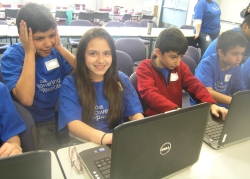Trying to figure out how to go 1:1 on scarce budgets? Try Leasing.
 Digital Wish put one-to-one computing in 30 schools and experimented with every imaginable funding mechanism. The biggest strides towards increasing technology came to those schools who adopted a leasing strategy. They were able to get as much as three times the equipment upfront, using their same annual budgets. How did they do it? Let’s break it down into simplest terms. Digital Wish put one-to-one computing in 30 schools and experimented with every imaginable funding mechanism. The biggest strides towards increasing technology came to those schools who adopted a leasing strategy. They were able to get as much as three times the equipment upfront, using their same annual budgets. How did they do it? Let’s break it down into simplest terms.
When a Lease Makes Sense
Technology is becoming an increasingly large budget item and many schools are avoiding huge upfront costs and adopting a leasing strategy. This allows schools to spread out the technology expenditure across the useful life of the equipment, making better use of limited budgets, and refreshing their equipment before it becomes obsolete.
When trying to decide whether to lease, consider how long your technology is expected to last. For non-1:1 schools, desktop devices can often last longer than the lease period and afterwards they can still be handed down to other grade levels. However, if you are working towards a 1:1 environment, remember that the devices will wear out much faster than stationary desktops, which means your equipment will need to be replaced faster. There is often no hand-me-down value for 1:1 devices, because the equipment is largely worn out by the time the students finish with it. This means once the technology runs its life cycle in the 1:1 program, it will probably need to be disposed of, regardless of whether it still holds value on the fair market.
There are 2 types of leases, a Fair Market Value (FMV) lease and a $1 Buyout lease.
The $1 Buyout Lease
With a $1 Buyout lease you pay for the entire cost of the hardware over the lease term, and you own the equipment at the end of term.
Example: When financing a $300 device, with a 3-year $1 Buyout Lease you’ll spread the cost of that device out over 3 years via an annual or monthly payment schedule.
Now compare a $1 Buyout lease, versus an outright purchase of equipment. With the lease, you can equip three times as many students with devices in the very first year, and spread the cost out over the 3-year term. This alone, may be enough for your school to tackle a 1:1 initiative now, instead of later.
Decoding the Fair Market Value (FMV) Lease
With a FMV lease the school doesn't pay for the ownership of the device but only use of the equipment.
Example: That same $300 device will lose approximately $100 of equity each year. If you are on a 2-year FMV lease you will only have paid about $200 for the device before you send it back. There are not disposal costs on worn out equipment.
A FMV lease can save a lot of money for a 1:1 program. Since there is probably no hand-me-down value for 1:1 devices, a FMV lease provides an option to get rid of worn out equipment before problems arise. It also means you can shorten the replacement cycle to 2-3 years, allowing you to replace the devices before they wear out. Then you can implement a Tech Refresh program and get new equipment again.
Add Software, PD and Installation to the Lease
Few schools are aware that you can add software, peripherals, telecom equipment, installation costs, warranties, freight, and even professional development into a single lease together with tablets and computers. This allows schools to set up a single and predictable annual payment for most of their technology needs to match the school’s annual budget.
Options to Consider
Most terms are negotiable with a lease, so here are some options you will want to consider:
-
Term: Select a 2, 3, or 4-year term. The longer the term, the lower the annual payment, and the more equipment you can get upfront with your same annual budget.
-
Tech Refresh: Consider the useful life of the equipment and how soon you want to replace it. At the end of a lease, you can do a Tech Refresh and replace your equipment (often) at the same annual payment.
-
Payment Plan: Many schools set up a one-time annual payment to simplify accounting, but a lease can be monthly, or any term to match the budget cycle.
-
Deferred Payments – Some lease options allow for the equipment to be delivered to your school well before your new fiscal budget starts, allowing schools to get the equipment ready prior to the next budget cycle.
-
End of Lease Options: At the end of the lease, you can upgrade your equipment, allow students to keep the equipment, or pass it down to lower grade levels. Some leases allow you to decide which equipment to keep and which to send back – so make sure to select options that best match your school’s technology plan.
-
$1 Buyout Option: This is ideal for high schools that lease devices for their 9th graders, and then gift the devices to the students upon graduation. Not only will this save on disposal costs, but it also reduces breakage rates because students take better care of equipment that they know will be theirs. It’s also a fantastic graduation present!
School Hurdles
 Leasing requires schools to step outside of their comfort zone of outright purchasing and consider an alternative financing strategy. We discovered it was common to find someone in the school administration who was against leasing “on principle”, so be prepared to ask hard questions like: Leasing requires schools to step outside of their comfort zone of outright purchasing and consider an alternative financing strategy. We discovered it was common to find someone in the school administration who was against leasing “on principle”, so be prepared to ask hard questions like:
-
Why do you want to own technology that will be obsolete in 3 years?
-
Leasing IT equipment is a common practice in the business world, so why shouldn’t schools take advantage of the same benefits by spreading costs over multiple budget years, and upgrading equipment regularly.
-
Schools borrow money to buy busses and replace roofs, why not 1:1 equipment too?
-
Schools may already be leasing copiers and other large ticket items. Is that working well for the school and taxpayers?
At the end of the day, it makes no material difference to students and teachers whether a device was leased or purchased. They will still treat classroom technology as the school’s own. Leasing is not a panacea, but for many schools it can shorten the march towards 1:1 computing by even years.
If you need help sorting out the leasing options, the nonprofit Digital Wish has staff with hard-won expertise in 1:1 computing and can help answer your questions.
Contact us: [email protected] or (866) 344-7758.
|